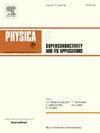Tilted solenoids magnet using superconducting stacked tapes
IF 1
3区 物理与天体物理
Q4 PHYSICS, APPLIED
Physica C-superconductivity and Its Applications
Pub Date : 2025-02-20
DOI:10.1016/j.physc.2025.1354667
引用次数: 0
Abstract
As a recently developed type of dipole field magnets, the tilted solenoids technology has great potential in various fields such as proton therapy, particle accelerators, and high-field applications. High-temperature superconducting materials can further enhance the magnetic field strength, reduce the bending radius, and lower the device cost. This research is based on differential geometry theory and proposes design methodology along with optimization principle for tilted solenoids magnet utilizing stacked high-temperature superconducting tapes. The engineering implementation strategies for tilted solenoid technology employing superconducting tapes are explored. Both single-turn and multi-turn coils are designed and fabricated respectively, and the critical currents are tested. Additionally, a double-layer tilted solenoids magnet was modeled; magnetic field simulation as well as higher-order analyses were conducted to validate the effectiveness of this methodology.
倾斜螺线管磁铁使用超导堆叠磁带
倾斜螺线管技术是近年来发展起来的一种新型偶极子场磁体,在质子治疗、粒子加速器和高场应用等领域具有很大的应用潜力。高温超导材料可以进一步增强磁场强度,减小弯曲半径,降低器件成本。本研究基于微分几何理论,提出了利用堆叠高温超导带的倾斜螺线管磁体的设计方法和优化原理。探讨了超导带倾斜螺线管技术的工程实现策略。分别设计制作了单匝线圈和多匝线圈,并进行了临界电流测试。此外,对双层倾斜螺线管磁铁进行了建模;磁场仿真和高阶分析验证了该方法的有效性。
本文章由计算机程序翻译,如有差异,请以英文原文为准。
求助全文
约1分钟内获得全文
求助全文
来源期刊
CiteScore
2.70
自引率
11.80%
发文量
102
审稿时长
66 days
期刊介绍:
Physica C (Superconductivity and its Applications) publishes peer-reviewed papers on novel developments in the field of superconductivity. Topics include discovery of new superconducting materials and elucidation of their mechanisms, physics of vortex matter, enhancement of critical properties of superconductors, identification of novel properties and processing methods that improve their performance and promote new routes to applications of superconductivity.
The main goal of the journal is to publish:
1. Papers that substantially increase the understanding of the fundamental aspects and mechanisms of superconductivity and vortex matter through theoretical and experimental methods.
2. Papers that report on novel physical properties and processing of materials that substantially enhance their critical performance.
3. Papers that promote new or improved routes to applications of superconductivity and/or superconducting materials, and proof-of-concept novel proto-type superconducting devices.
The editors of the journal will select papers that are well written and based on thorough research that provide truly novel insights.

 求助内容:
求助内容: 应助结果提醒方式:
应助结果提醒方式:


